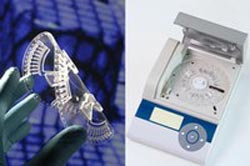Rapid Detection of Malaria

source: IMTEK/Bernd Müller<br>
An estimated 220 million people become infected with malaria each year. The disease is often lethal – particularly in tropical developing countries with insufficient health care services.
The infected suffer from a high fever. As this is also the case with other germs, however, it is important to conduct a rapid and precise analysis to determine the cause of the disease for a successful therapy. A team of researchers aims to develop a rapid test of this kind within the context of the project DiscoGnosis.
Launched in November 2012, the project will receive three million euros in funding from the European Union and is being coordinated by the Department of Microsystems Engineering (IMTEK) of the University of Freiburg.
DiscoGnosis stands for “disc-shaped point-of-care platform for infectious disease diagnosis” – a device that looks similar to a DVD player. Its purpose will be to purify patients’ blood samples and detect all relevant fever-causing germs in a single step. The institutions responsible for the project want to develop an inexpensive method for determining whether a person with fever has malaria or not. Studies have shown that 30 to 40 percent of patients being treated for malaria are actually suffering from typhus or dengue fever.
Each disc will be intended for one use only and will be capable of making a reliable diagnosis automatically with the help of integrated biochemical analytical processes. The innovation thus has the potential to bring modern diagnostics to countries and regions with poor infrastructure and improve the health care of entire populations. Ultimately, it could serve as a shield to stop the spread of malaria in Europe, which is currently being exacerbated by climate change.
IMTEK’s partners in the consortium are the University Medical Center Göttingen, the University Hospital Basel, Switzerland, the Swiss tool technology and engineering company Rohrer AG, the biotechnology companies MagnaMedics Diagnostics BV from the Netherlands and MAST Group Ltd. from Great Britain, and the European Foundation for Clinical Nanomedicine.
Further Information:
www.pr.uni-freiburg.de/go/discognosis
Contact:
Dr. Konstantinos Mitsakakis
Project Coordinator
Department of Microsystems Engineering, Laboratory for MEMS Applications
University of Freiburg
Phone: +49 (0)761/203-73252
E-Mail: konstantinos.mitsakakis@imtek.uni-freiburg.de
Katrin Grötzinger
PR & Marketing
Department of Microsystems Engineering
University of Freiburg
Phone: +49 (0)761/203-73242
E-Mail: katrin.groetzinger@imtek.uni-freiburg.de
Media Contact
All latest news from the category: Medical Engineering
The development of medical equipment, products and technical procedures is characterized by high research and development costs in a variety of fields related to the study of human medicine.
innovations-report provides informative and stimulating reports and articles on topics ranging from imaging processes, cell and tissue techniques, optical techniques, implants, orthopedic aids, clinical and medical office equipment, dialysis systems and x-ray/radiation monitoring devices to endoscopy, ultrasound, surgical techniques, and dental materials.
Newest articles

High-energy-density aqueous battery based on halogen multi-electron transfer
Traditional non-aqueous lithium-ion batteries have a high energy density, but their safety is compromised due to the flammable organic electrolytes they utilize. Aqueous batteries use water as the solvent for…

First-ever combined heart pump and pig kidney transplant
…gives new hope to patient with terminal illness. Surgeons at NYU Langone Health performed the first-ever combined mechanical heart pump and gene-edited pig kidney transplant surgery in a 54-year-old woman…

Biophysics: Testing how well biomarkers work
LMU researchers have developed a method to determine how reliably target proteins can be labeled using super-resolution fluorescence microscopy. Modern microscopy techniques make it possible to examine the inner workings…





















